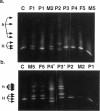Abstract
To better understand the molecular genetic basis and genetic epidemiology of Laron syndrome (growth-hormone insensitivity syndrome), we analyzed the growth-hormone receptor (GHR) genes of seven unrelated affected individuals from the United States, South America, Europe, and Africa. We amplified all nine GHR gene exons and splice junctions from these individuals by PCR and screened the products for mutations by using denaturing gradient gel electrophoresis (DGGE). We identified a single GHR gene fragment with abnormal DGGE results for each affected individual, sequenced this fragment, and, in each case, identified a mutation likely to cause Laron syndrome, including two nonsense mutations (R43X and R217X), two splice-junction mutations, (189-1 G to T and 71 + 1 G to A), and two frameshift mutations (46 del TT and 230 del TA or AT). Only one of these mutations, R43X, has been previously reported. Using haplotype analysis, we determined that this mutation, which involves a CpG dinucleotide hot spot, likely arose as a separate event in this case, relative to the two prior reports of R43X. Aside from R43X, the mutations we identified are unique to patients from particular geographic regions. Ten GHR gene mutations have now been described in this disorder. We conclude that Laron syndrome is caused by diverse GHR gene mutations, including deletions, RNA processing defects, translational stop codons, and missense codons. All the identified mutations involve the extracellular domain of the receptor, and most are unique to particular families or geographic areas.
Full text
PDF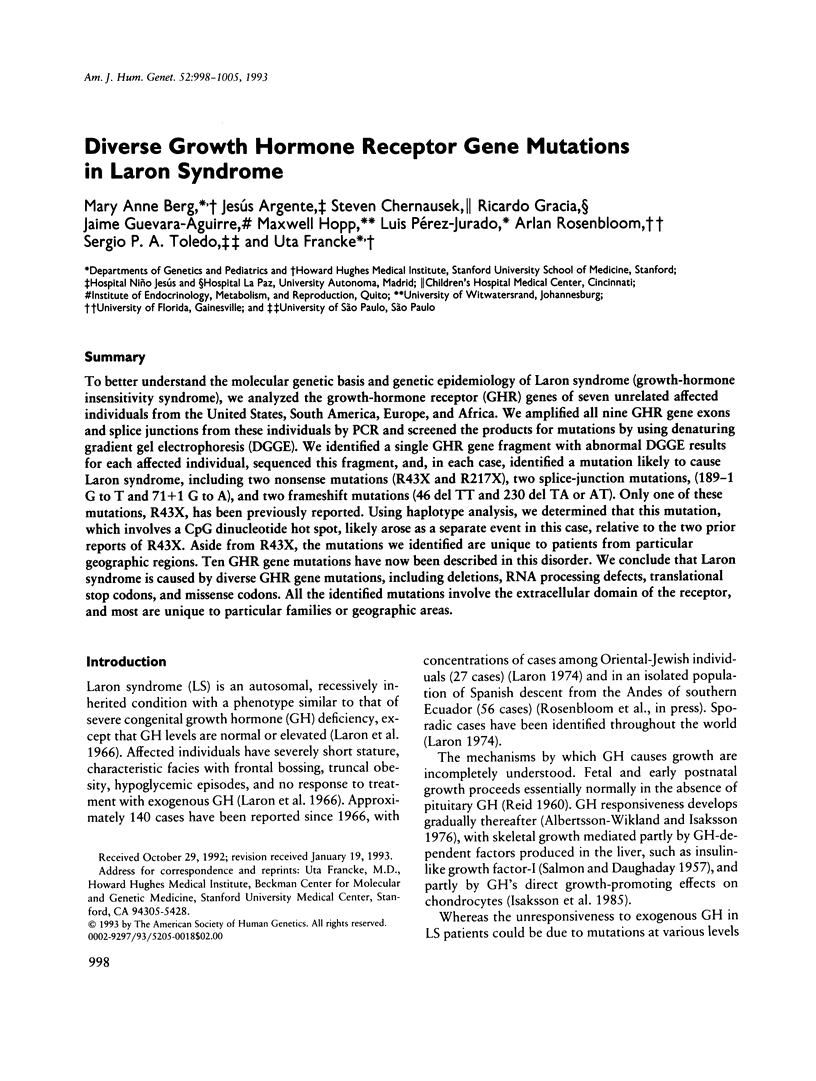

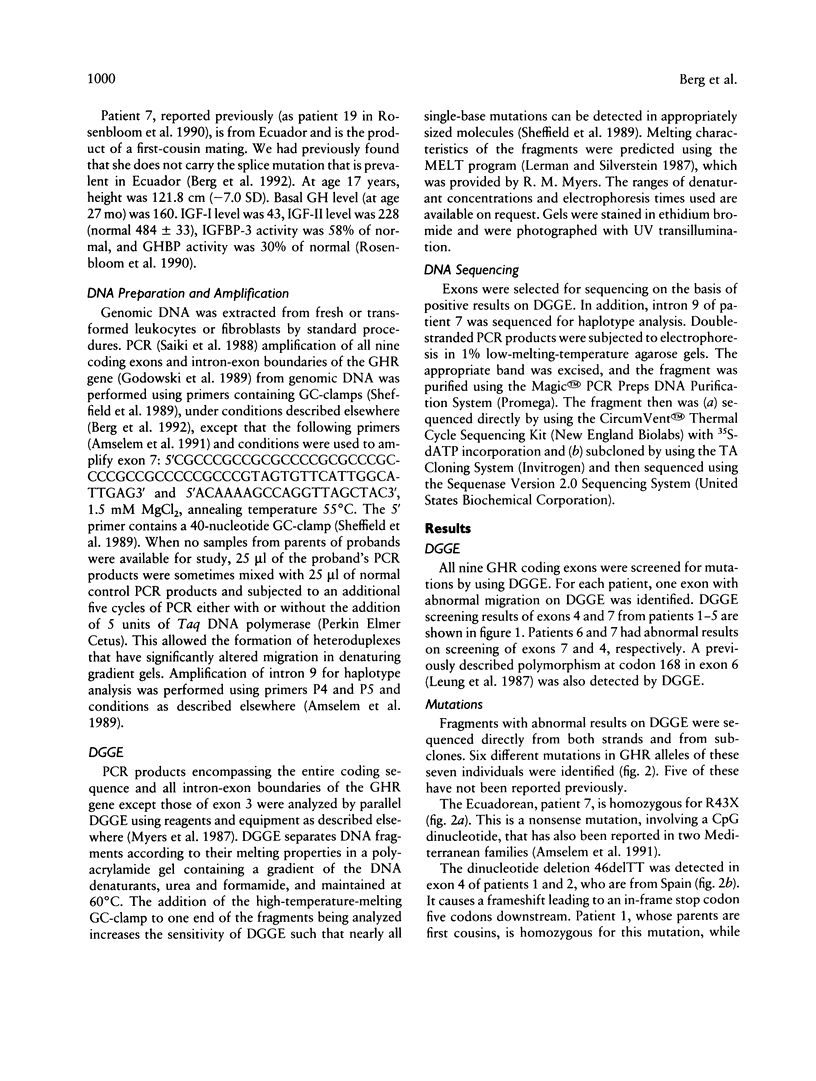
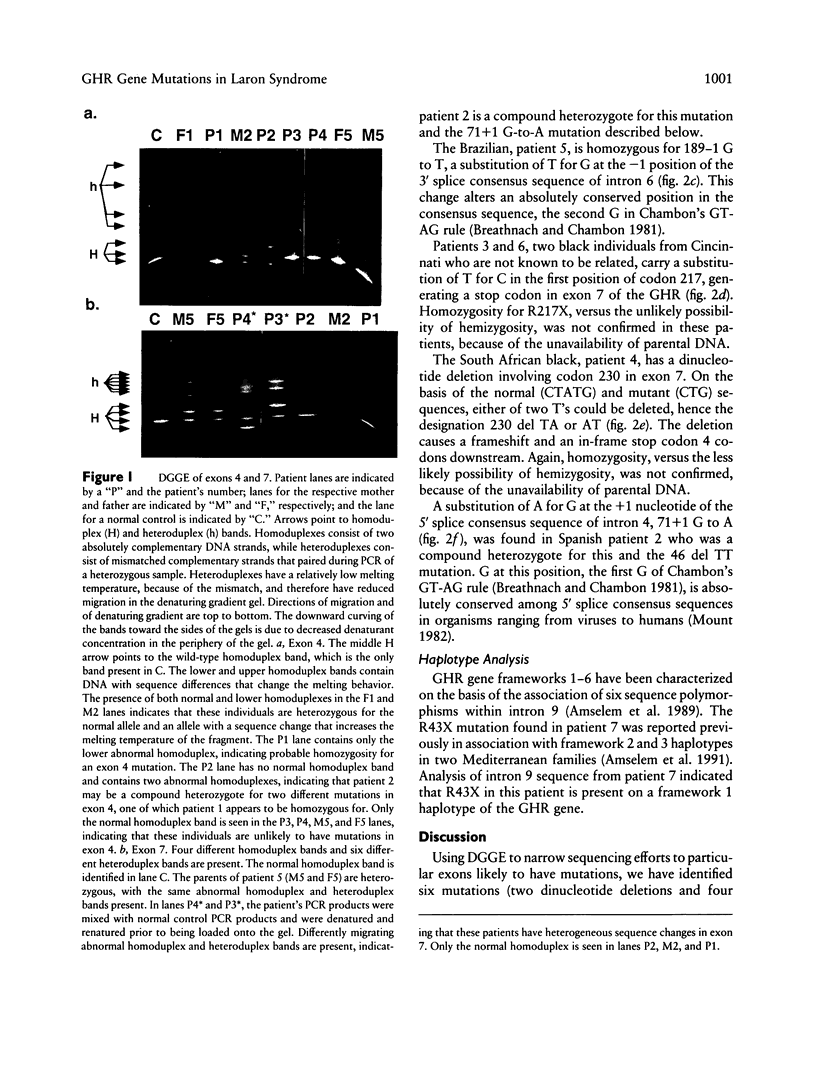
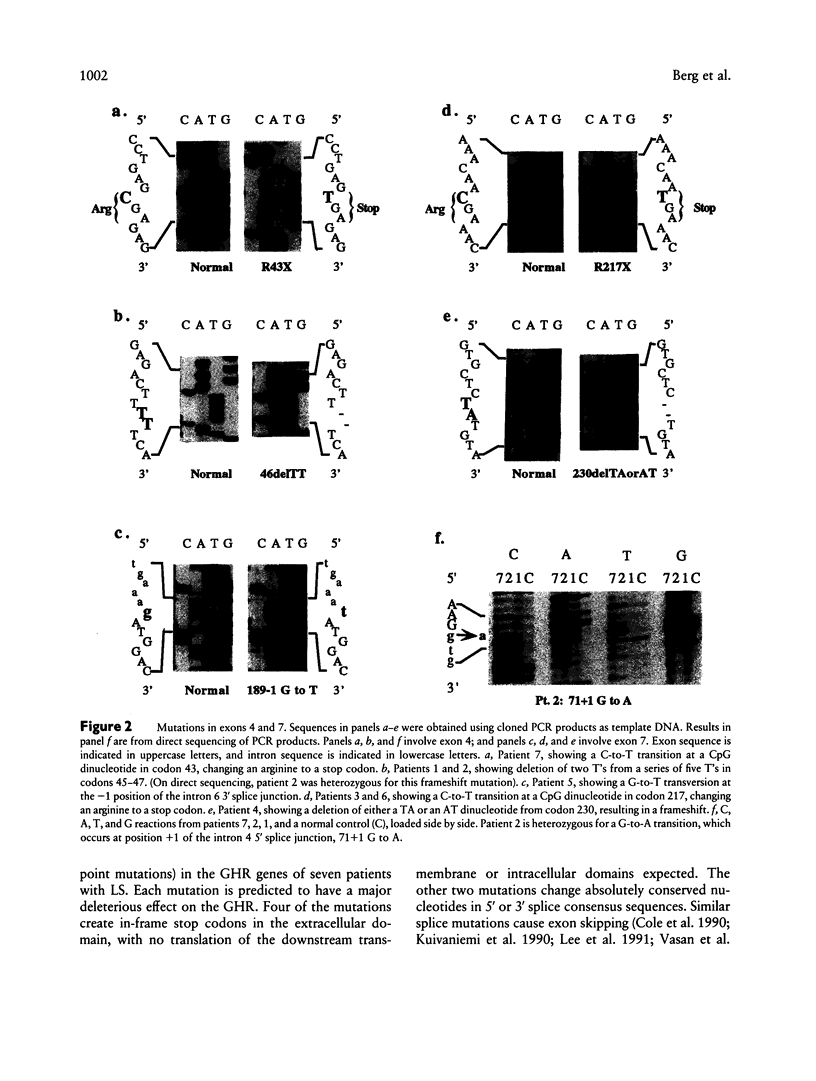
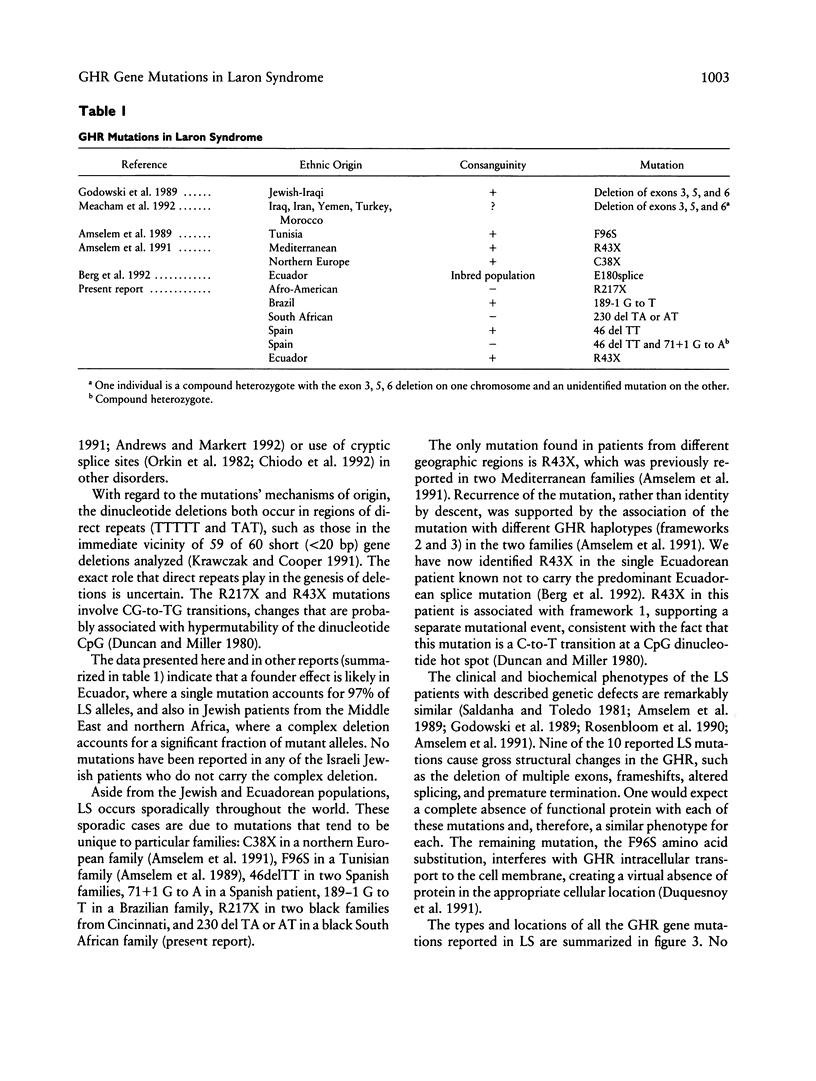


Images in this article
Selected References
These references are in PubMed. This may not be the complete list of references from this article.
- Albertsson-Wikland K., Isaksson O. Development of responsiveness of young normal rats to growth hormone. Metabolism. 1976 Jul;25(7):747–759. doi: 10.1016/0026-0495(76)90146-3. [DOI] [PubMed] [Google Scholar]
- Amselem S., Duquesnoy P., Attree O., Novelli G., Bousnina S., Postel-Vinay M. C., Goossens M. Laron dwarfism and mutations of the growth hormone-receptor gene. N Engl J Med. 1989 Oct 12;321(15):989–995. doi: 10.1056/NEJM198910123211501. [DOI] [PubMed] [Google Scholar]
- Amselem S., Sobrier M. L., Duquesnoy P., Rappaport R., Postel-Vinay M. C., Gourmelen M., Dallapiccola B., Goossens M. Recurrent nonsense mutations in the growth hormone receptor from patients with Laron dwarfism. J Clin Invest. 1991 Mar;87(3):1098–1102. doi: 10.1172/JCI115071. [DOI] [PMC free article] [PubMed] [Google Scholar]
- Andrews L. G., Markert M. L. Exon skipping in purine nucleoside phosphorylase mRNA processing leading to severe immunodeficiency. J Biol Chem. 1992 Apr 15;267(11):7834–7838. [PubMed] [Google Scholar]
- Berg M. A., Guevara-Aguirre J., Rosenbloom A. L., Rosenfeld R. G., Francke U. Mutation creating a new splice site in the growth hormone receptor genes of 37 Ecuadorean patients with Laron syndrome. Hum Mutat. 1992;1(1):24–32. doi: 10.1002/humu.1380010105. [DOI] [PubMed] [Google Scholar]
- Breathnach R., Chambon P. Organization and expression of eucaryotic split genes coding for proteins. Annu Rev Biochem. 1981;50:349–383. doi: 10.1146/annurev.bi.50.070181.002025. [DOI] [PubMed] [Google Scholar]
- Chiodo A. A., Hockey A., Cole W. G. A base substitution at the splice acceptor site of intron 5 of the COL1A2 gene activates a cryptic splice site within exon 6 and generates abnormal type I procollagen in a patient with Ehlers-Danlos syndrome type VII. J Biol Chem. 1992 Mar 25;267(9):6361–6369. [PubMed] [Google Scholar]
- Cole W. G., Chiodo A. A., Lamande S. R., Janeczko R., Ramirez F., Dahl H. H., Chan D., Bateman J. F. A base substitution at a splice site in the COL3A1 gene causes exon skipping and generates abnormal type III procollagen in a patient with Ehlers-Danlos syndrome type IV. J Biol Chem. 1990 Oct 5;265(28):17070–17077. [PubMed] [Google Scholar]
- Daughaday W. H., Trivedi B. Absence of serum growth hormone binding protein in patients with growth hormone receptor deficiency (Laron dwarfism). Proc Natl Acad Sci U S A. 1987 Jul;84(13):4636–4640. doi: 10.1073/pnas.84.13.4636. [DOI] [PMC free article] [PubMed] [Google Scholar]
- Duncan B. K., Miller J. H. Mutagenic deamination of cytosine residues in DNA. Nature. 1980 Oct 9;287(5782):560–561. doi: 10.1038/287560a0. [DOI] [PubMed] [Google Scholar]
- Duquesnoy P., Sobrier M. L., Amselem S., Goossens M. Defective membrane expression of human growth hormone (GH) receptor causes Laron-type GH insensitivity syndrome. Proc Natl Acad Sci U S A. 1991 Nov 15;88(22):10272–10276. doi: 10.1073/pnas.88.22.10272. [DOI] [PMC free article] [PubMed] [Google Scholar]
- Eshet R., Laron Z., Pertzelan A., Arnon R., Dintzman M. Defect of human growth hormone receptors in the liver of two patients with Laron-type dwarfism. Isr J Med Sci. 1984 Jan;20(1):8–11. [PubMed] [Google Scholar]
- Godowski P. J., Leung D. W., Meacham L. R., Galgani J. P., Hellmiss R., Keret R., Rotwein P. S., Parks J. S., Laron Z., Wood W. I. Characterization of the human growth hormone receptor gene and demonstration of a partial gene deletion in two patients with Laron-type dwarfism. Proc Natl Acad Sci U S A. 1989 Oct;86(20):8083–8087. doi: 10.1073/pnas.86.20.8083. [DOI] [PMC free article] [PubMed] [Google Scholar]
- Isaksson O. G., Edén S., Jansson J. O. Mode of action of pituitary growth hormone on target cells. Annu Rev Physiol. 1985;47:483–499. doi: 10.1146/annurev.ph.47.030185.002411. [DOI] [PubMed] [Google Scholar]
- Krawczak M., Cooper D. N. Gene deletions causing human genetic disease: mechanisms of mutagenesis and the role of the local DNA sequence environment. Hum Genet. 1991 Mar;86(5):425–441. doi: 10.1007/BF00194629. [DOI] [PubMed] [Google Scholar]
- Kuivaniemi H., Kontusaari S., Tromp G., Zhao M. J., Sabol C., Prockop D. J. Identical G+1 to A mutations in three different introns of the type III procollagen gene (COL3A1) produce different patterns of RNA splicing in three variants of Ehlers-Danlos syndrome. IV. An explanation for exon skipping some mutations and not others. J Biol Chem. 1990 Jul 15;265(20):12067–12074. [PubMed] [Google Scholar]
- Laron Z., Pertzelan A., Mannheimer S. Genetic pituitary dwarfism with high serum concentation of growth hormone--a new inborn error of metabolism? Isr J Med Sci. 1966 Mar-Apr;2(2):152–155. [PubMed] [Google Scholar]
- Laron Z. The syndrome of familial dwarfism and high plasma immunoreactive human growth hormone. Birth Defects Orig Artic Ser. 1974;10(4):231–238. [PubMed] [Google Scholar]
- Lee B., Vitale E., Superti-Furga A., Steinmann B., Ramirez F. G to T transversion at position +5 of a splice donor site causes skipping of the preceding exon in the type III procollagen transcripts of a patient with Ehlers-Danlos syndrome type IV. J Biol Chem. 1991 Mar 15;266(8):5256–5259. [PubMed] [Google Scholar]
- Lerman L. S., Silverstein K. Computational simulation of DNA melting and its application to denaturing gradient gel electrophoresis. Methods Enzymol. 1987;155:482–501. doi: 10.1016/0076-6879(87)55032-7. [DOI] [PubMed] [Google Scholar]
- Leung D. W., Spencer S. A., Cachianes G., Hammonds R. G., Collins C., Henzel W. J., Barnard R., Waters M. J., Wood W. I. Growth hormone receptor and serum binding protein: purification, cloning and expression. Nature. 1987 Dec 10;330(6148):537–543. doi: 10.1038/330537a0. [DOI] [PubMed] [Google Scholar]
- Mount S. M. A catalogue of splice junction sequences. Nucleic Acids Res. 1982 Jan 22;10(2):459–472. doi: 10.1093/nar/10.2.459. [DOI] [PMC free article] [PubMed] [Google Scholar]
- Myers R. M., Maniatis T., Lerman L. S. Detection and localization of single base changes by denaturing gradient gel electrophoresis. Methods Enzymol. 1987;155:501–527. doi: 10.1016/0076-6879(87)55033-9. [DOI] [PubMed] [Google Scholar]
- Orkin S. H., Kazazian H. H., Jr, Antonarakis S. E., Ostrer H., Goff S. C., Sexton J. P. Abnormal RNA processing due to the exon mutation of beta E-globin gene. Nature. 1982 Dec 23;300(5894):768–769. doi: 10.1038/300768a0. [DOI] [PubMed] [Google Scholar]
- REID J. D. Congenital absence of the pituitary gland. J Pediatr. 1960 May;56:658–664. doi: 10.1016/s0022-3476(60)80341-1. [DOI] [PubMed] [Google Scholar]
- Rosenbloom A. L., Guevara Aguirre J., Rosenfeld R. G., Fielder P. J. The little women of Loja--growth hormone-receptor deficiency in an inbred population of southern Ecuador. N Engl J Med. 1990 Nov 15;323(20):1367–1374. doi: 10.1056/NEJM199011153232002. [DOI] [PubMed] [Google Scholar]
- SALMON W. D., Jr, DAUGHADAY W. H. A hormonally controlled serum factor which stimulates sulfate incorporation by cartilage in vitro. J Lab Clin Med. 1957 Jun;49(6):825–836. [PubMed] [Google Scholar]
- Saiki R. K., Gelfand D. H., Stoffel S., Scharf S. J., Higuchi R., Horn G. T., Mullis K. B., Erlich H. A. Primer-directed enzymatic amplification of DNA with a thermostable DNA polymerase. Science. 1988 Jan 29;239(4839):487–491. doi: 10.1126/science.2448875. [DOI] [PubMed] [Google Scholar]
- Saldanha P. H., Toledo S. P. Familial dwarfism with high IR-GH: report of two affected sibs with genetic and epidemiologic considerations. Hum Genet. 1981;59(4):367–372. doi: 10.1007/BF00295474. [DOI] [PubMed] [Google Scholar]
- Sheffield V. C., Cox D. R., Lerman L. S., Myers R. M. Attachment of a 40-base-pair G + C-rich sequence (GC-clamp) to genomic DNA fragments by the polymerase chain reaction results in improved detection of single-base changes. Proc Natl Acad Sci U S A. 1989 Jan;86(1):232–236. doi: 10.1073/pnas.86.1.232. [DOI] [PMC free article] [PubMed] [Google Scholar]
- Trivedi B., Daughaday W. H. Release of growth hormone binding protein from IM-9 lymphocytes by endopeptidase is dependent on sulfhydryl group inactivation. Endocrinology. 1988 Nov;123(5):2201–2206. doi: 10.1210/endo-123-5-2201. [DOI] [PubMed] [Google Scholar]
- Vasan N. S., Kuivaniemi H., Vogel B. E., Minor R. R., Wootton J. A., Tromp G., Weksberg R., Prockop D. J. A mutation in the pro alpha 2(I) gene (COL1A2) for type I procollagen in Ehlers-Danlos syndrome type VII: evidence suggesting that skipping of exon 6 in RNA splicing may be a common cause of the phenotype. Am J Hum Genet. 1991 Feb;48(2):305–317. [PMC free article] [PubMed] [Google Scholar]
- de Vos A. M., Ultsch M., Kossiakoff A. A. Human growth hormone and extracellular domain of its receptor: crystal structure of the complex. Science. 1992 Jan 17;255(5042):306–312. doi: 10.1126/science.1549776. [DOI] [PubMed] [Google Scholar]



